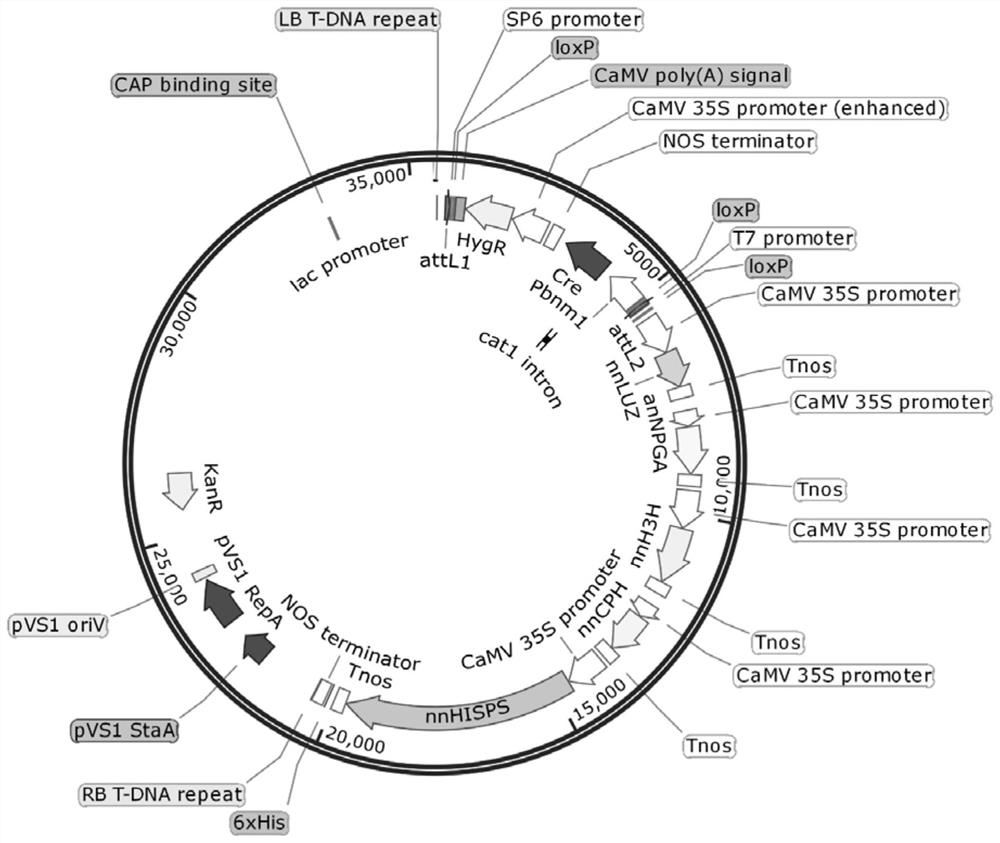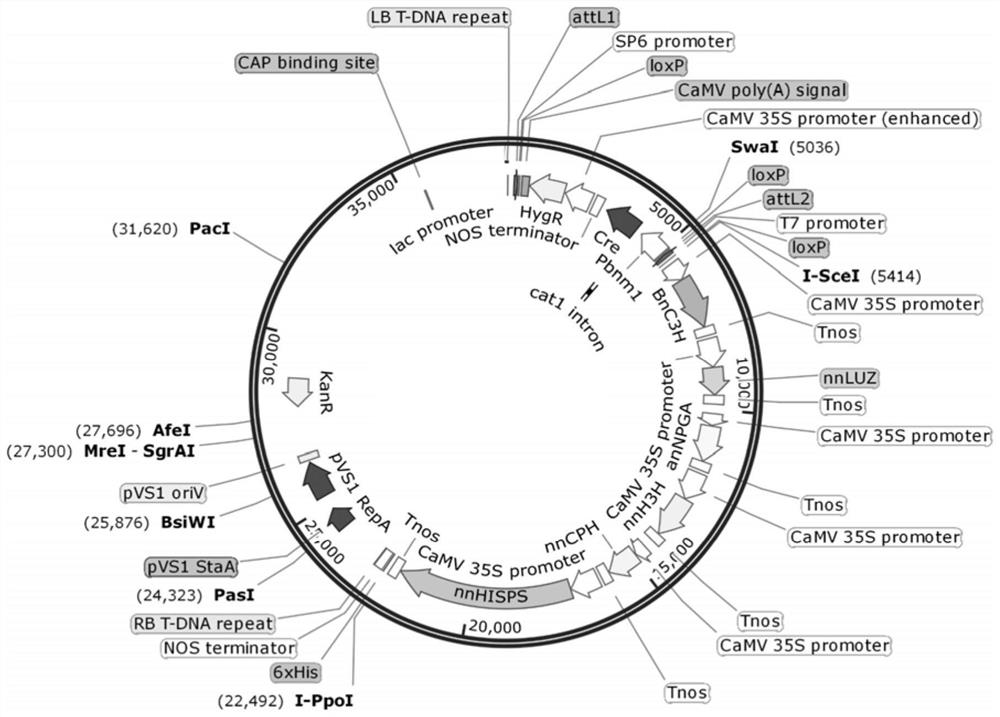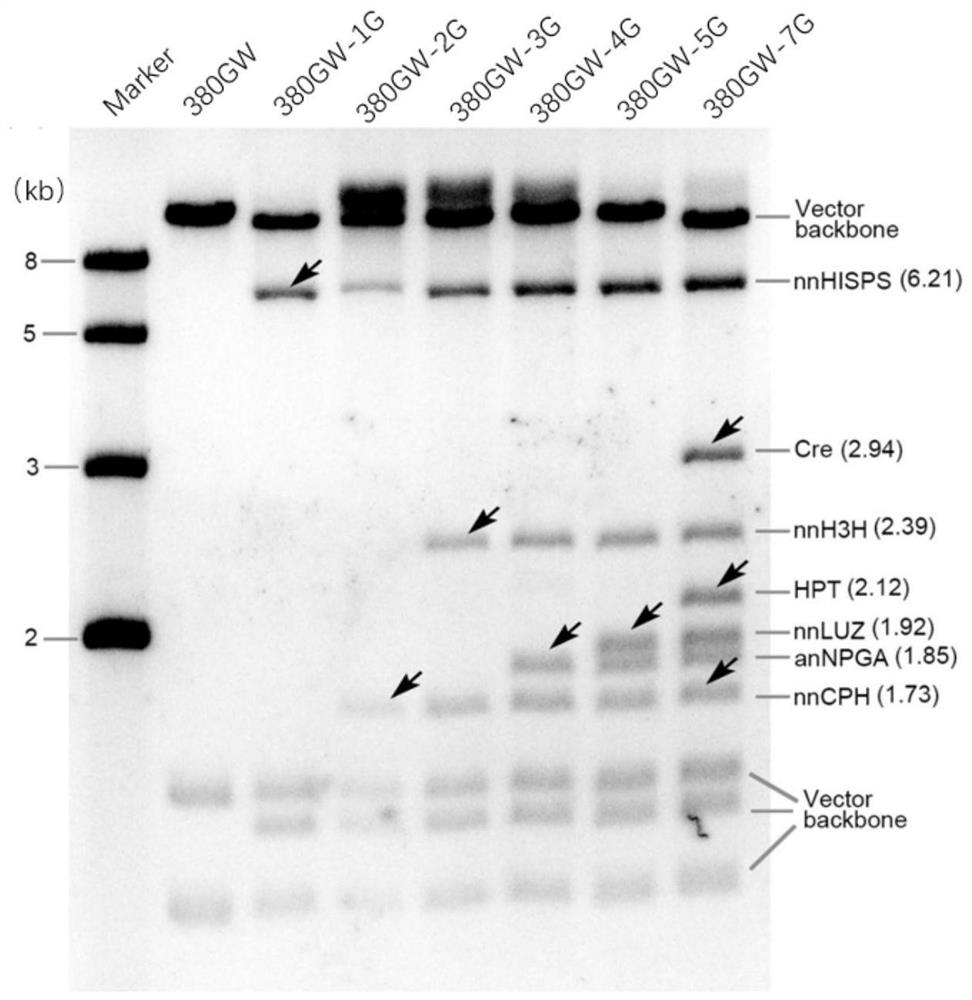Application of oilseed rape BnC3H gene in improving biological self-luminous intensity of plants
A self-luminous and genetic technology, applied in the biological field, can solve the problems of not making a fundamental breakthrough and not yet put into production, and achieve the effect of improving the intensity of biological self-luminescence
- Summary
- Abstract
- Description
- Claims
- Application Information
AI Technical Summary
Problems solved by technology
Method used
Image
Examples
Embodiment 1
[0045] Example 1 Construction process of large fragment bioluminescence module DNA vector pYLTAC380GW-7G / 8G
[0046] In this study, the TransGene Stacking II system was used for multigene assembly. The NPGA (4'-phosphopantetheinyl transferase) gene in the Aspergillus nidulans genome, the H3H (hispidin-3-hydroxylase) gene and the Hisps (Hispidin synthase) gene in the Neonothopanus nambi genome, and the CPH ( Caffey pyruvate hydrolase) gene, rapeseed p-coumaric acid 3-hydroxylase BnC3H (p-coumaric acid 3-hydroxylase) driven by 35S promoter and fungal luciferase (Luz) gene were integrated into the pYLTAC380GW plasmid, and finally passed one step The BP recombination reaction connects and removes the selection marker gene expression cassette element to form a basic vector
[0047] pYLTAC380GW-Hisps-CPH-H3H-NPGA-Luz (pYLTAC380GW-7G) ( figure 1 ), the enhanced carrier
[0048] pYLTAC380GW-Hisps-CPH-H3H-NPGA-Luz-BnC3H (pYLTAC380GW-8G), the enhanced vector contains overexpressed ra...
Embodiment 2
[0059] Example 2 Analysis of Luminescence Intensity After Transient Transformation of Phalaenopsis Petals by Biological Self-luminescence Module
[0060] 1. Streak and activate the EHA105 bacterial solution containing the verified correct vector plasmid pYLTAC380GW-7G / 8G on the LA+Kana+Rif plate, 28°C, 36h, pick colonies from each plate, and transfer them to LB+ Culture in Kana+Rif+15μM As medium, 28℃, 200rpm to OD 600 =0.8-1.0, 4000rpm, 10min to collect the bacterial cells, suspend the Agrobacterium bacterial cells with the infection solution (containing 10mM MgCl, 10mM MES, 150μM As), and let stand at room temperature for 2-3h.
[0061] 2. To verify the transient expression in the Phalaenopsis petals, use a 1mL needle to gently open a small opening on the surface of the Phalaenopsis petals, then use the needle tube with the needle removed to absorb the bacterial liquid, and inject it into the petals from the wound of the Phalaenopsis petals. Indoor normal cultivation for 48...
Embodiment 3
[0063] Example 3 Analysis of Luminescence Intensity of Transgenic Plants of Tobacco Bioself-luminescence Module Mediated by Agrobacterium
[0064]1. Streak the EHA105 bacterial solution containing the verified correct vector plasmid pYLTAC380GW-7G / 8G on the LA+Rif+Kana plate, 28°C, 36h, pick a single clone into 3-5ml LB medium at 200rpm, 28°C , 36h, according to the ratio of 1:100-1:50, expand the culture of 50ml for 3-5h to OD=0.6, then centrifuge the bacterial solution, and suspend the bacteria with MS0 liquid medium (MS+3%Sucrose+PH5.8, 50ml) Body to OD=0.6 for infection;
[0065] 2. Select healthy tobacco leaves (4-5 weeks) that have fully unfolded, cut them into 0.5cm square size with a scalpel (cut off the leaf edge to avoid the main vein), and place the upper surface of the leaf downward on MS1 solid medium (MS+0.5 mg / L IAA+2.0mg / L BA+3% sucrose+0.6-0.8% Phytagel, pH=5.8), culture in dark at 25°C for 2-3 days;
[0066] 3. Add the pre-cultured tobacco leaves to the b...
PUM
 Login to View More
Login to View More Abstract
Description
Claims
Application Information
 Login to View More
Login to View More - R&D
- Intellectual Property
- Life Sciences
- Materials
- Tech Scout
- Unparalleled Data Quality
- Higher Quality Content
- 60% Fewer Hallucinations
Browse by: Latest US Patents, China's latest patents, Technical Efficacy Thesaurus, Application Domain, Technology Topic, Popular Technical Reports.
© 2025 PatSnap. All rights reserved.Legal|Privacy policy|Modern Slavery Act Transparency Statement|Sitemap|About US| Contact US: help@patsnap.com



